Flavonoid Profiles of Two New Approved Romanian Ocimum Hybrids
Abstract
1. Introduction
2. Results
2.1. Phytochemical Characterization of the Romanian Varieties of Basil
2.1.1. Polyphenolic Acid Content
2.1.2. Flavonoid Content
2.2. Antioxidant Potentials of the Romanian Varieties of Basil
2.2.1. DPPH Assay
2.2.2. Electrochemical Evaluation of Antioxidant Capacity by Cyclic Voltammetry
2.3. HPLC-DAD Separation, Identification and Quantification of Flavonoid Compounds
3. Disscusion
3.1. Phytochemical Characterization of the Romanian Varieties of Basil
3.2. Antioxidant Potentials of the Romanian Varieties of Basil
3.3. HPLC-DAD Separation, Identification and Quantification of Flavonoid Compounds
4. Materials and Methods
4.1. Romanian Basil Hybrid Plant Materials
4.2. Sample Preparation
4.3. Phytochemical characterization of the Romanian Varieties of Basil
4.3.1. Phenolic Acids content
4.3.2. Flavonoids Content
4.4. Antioxidant Potentials of the Romanian Varieties of Basil
4.4.1. DPPH assay
4.4.2. Electrochemical Evaluation of Antioxidant Capacity by Cyclic Voltammetry
4.5. HPLC-DAD Separation, Identification and Quantification of Flavonoid Compounds
4.6. Statistical Analysis
5. Conclusions
Author Contributions
Funding
Acknowledgments
Conflicts of Interest
References
- Chenni, M.; El Abed, D.; Rakotomanomana, N.; Fernandez, X.; Chemat, F. Comparative Study of Essential Oils Extracted from Egyptian Basil Leaves (Ocimum basilicum L.) Using Hydro-Distillation and Solvent-Free Microwave Extraction. Molecules 2016, 21, 113. [Google Scholar] [CrossRef] [PubMed]
- Tangpao, T.; Chung, H.H.; Sommano, S.R. Aromatic Profiles of Essential Oils from Five Commonly Used Thai Basils. Foods 2018, 7, 175. [Google Scholar] [CrossRef] [PubMed]
- Li, Y.R.; Li, G.H.; Zhou, M.X.; Xiang, L.; Ren, D.M.; Lou, H.X.; Wang, X.N.; Shen, T. Discovery of natural flavonoids as activators of Nrf2-mediated defense system. Bioorganic Med. Chem. 2018, 26, 5140–5150. [Google Scholar] [CrossRef] [PubMed]
- Zhai, X.; Lin, M.; Zhang, F.; Hu, Y.; Xu, X.; Li, Y.; Liu, K.; Ma, X.; Tian, X.; Yao, J. Dietary flavonoid genistein induces Nrf2 and phase II detoxification gene expression via ERKs and PKC pathways and protects against oxidative stress in Caco-2 cells. Mol. Nutr. Food Res. 2013, 57, 249–259. [Google Scholar] [CrossRef] [PubMed]
- Leonardo, C.C.; Doré, S. Dietary flavonoids are neuroprotective through Nrf2-coordinated induction of endogenous cytoprotective proteins. Nutr. Neurosci. 2011, 14, 226–236. [Google Scholar] [CrossRef] [PubMed]
- Heo, H.J.; Kim, D.K.; Shin, S.C.; Kim, M.J.; Kim, B.Y.; Shin, D.G. Effect of Antioxidant Flavanone, Naringenin, from Citrus junos on Neuroprotection. J. Agric. Food Chem. 2004, 52, 1520–1525. [Google Scholar] [CrossRef]
- Mendonca, P.; Soliman, K.F.A. Flavonoids Activation of the Transcription Factor Nrf2 as a Hypothesis Approach for the Prevention and Modulation of SARS-CoV-2 Infection Severity. Antioxidants 2020, 9, 659. [Google Scholar] [CrossRef]
- Alam, A.M.; Subhan, N.; Rahman, M.M.; Uddin, S.J.; Reza, H.M.; Sarker, S.D. Effect of Citrus Flavonoids, Naringin and Naringenin, on Metabolic Syndrome and Their Mechanisms of Action. American Society for Nutrition. Adv. Nutr. 2014, 5, 404–417. [Google Scholar] [CrossRef]
- Yao, Q.; Lin, M.T.; Zhu, Y.D.; Xu, H.L.; Zhao, Y.Z. Recent Trends in Potential Therapeutic Applications of the Dietary Flavonoid Didymin. Molecules 2018, 23, 2547. [Google Scholar] [CrossRef]
- Nijveldt, R.J.; van Nood, E.; van Hoorn, D.E.; Boelens, P.G.; van Norren, K.; van Leeuwen, P.A. Flavonoids: A review of probable mechanisms of action and potential applications. Am. J. Clin. Nutr. 2001, 74, 418–425. [Google Scholar] [CrossRef]
- Julsing, M.K.; Koulman, A.; Woerdenbag, H.J.; Quax, W.J.; Kayser, O. Combinatorial biosynthesis of medicinal plant secondary metabolites. Biomol. Eng. 2006, 23, 265–279. [Google Scholar] [CrossRef] [PubMed]
- Trantas, E.; Panopoulos, N.; Ververidis, F. Metabolic engineering of the complete pathway leading to heterologous biosynthesis of various flavonoids and stilbenoids in Saccharomyces cerevisiae. Metab. Eng. 2009, 11, 355–366. [Google Scholar] [CrossRef] [PubMed]
- Agic, D.; Brkic, H.; Tomic, S.; Karacic, Z.; Spoljarevic, M.; Lisjak, M.; Beslo, D.; Abramic, M. Validation of flavonoids as potential dipeptidyl peptidase III inhibitors: Experimental and computational approach. Chem. Biol. Drug Des. 2017, 89, 619–627. [Google Scholar] [CrossRef] [PubMed]
- Masek, A.; Chrzescijanska, E.; Latos, M.; Zaborski, M. Influence of hydroxyl substitution on flavanone antioxidants properties. Food Chem. 2016. [Google Scholar] [CrossRef]
- Kapoor, R.; Sirohi, V.K.; Gupta, K.; Dwivedi, A. Naringenin ameliorates progression of endometriosis by modulating Nrf2/Keap1/HO1 axis and inducing apoptosis in rats. J. Nutr. Biochem. 2019, 70, 215–226. [Google Scholar] [CrossRef]
- Naeini, F.; Namkhah, Z.; Ostadrahimi, A.; Tutunchi, H.; Hosseinzadeh-Attar, M.J. A Comprehensive Systematic Review of the Effects of Naringenin, a Citrus-Derived Flavonoid, on Risk Factors for Nonalcoholic Fatty Liver Disease. Am. Soc. Nutr. 2020, 1–16. [Google Scholar] [CrossRef]
- Zhao, L.; Wang, Y.; Liu, J.; Wang, K.; Guo, X.X.; Ji, B.; Wu, W.; Zhou, F. Protective Effects of Genistein and Puerarin against Chronic Alcohol-Induced Liver Injury in Mice via Antioxidant, Anti-Inflammatory, and Anti-Apoptotic Mechanisms. J. Agric. Food Chem. 2016, 2–31. [Google Scholar] [CrossRef]
- Hakkim, F.L.; Arivazhagan, G.; Boopathy, R. Antioxidant property of selected Ocimum species and their secondary metabolite content. J. Med. Plants Res. 2008, 2, 250–257. [Google Scholar]
- Purushothaman, B.; Srinivasan, R.P.; Suganthi, P.; Ranganathan, B.; Gimbun, J.; Shanmugam, K. A Comprehensive Review on Ocimumbasilicum. J. Nat. Remedies 2018, 18, 71–85. [Google Scholar] [CrossRef]
- Vînătoru, C.; MușatZamfir, B.; Bratu, C.; Peticilă, A. Results and perspectives in Ocimumbasilicum (basil) breeding at vegetable research and development station Buzău. Horticulture 2019, LXIII, 161–168. [Google Scholar]
- Falowo, A.B.; Mukumbo, F.E.; Idamokoro, E.M.; Afolayan, A.J.; Muchenje, V. Phytochemical Constituents and Antioxidant Activity of Sweet Basil (Ocimumbasilicum L.) Essential Oil on Ground Beef from Boran and Nguni Cattle. Hindawi Int. J. Food Sci. 2019, 1–8. [Google Scholar] [CrossRef]
- Majdi, C.; Pereira, C.; Dias, M.I.; Calhelha, R.C.; Alves, M.J.; Rhourri-Frih, B.; Charrouf, Z.; Barros, L.; Amaral, J.S.; Ferreira, I.C.F.R. Phytochemical Characterization and Bioactive Properties of Cinnamon Basil (Ocimum basilicum cv. ‘Cinnamon’) and Lemon Basil (Ocimum x citriodorum). Antioxidants 2020, 9, 369. [Google Scholar] [CrossRef] [PubMed]
- Mohsen, S.M.; Ammar, A.S.M. Total phenolic contents and antioxidant activity of corn tassel extracts. Food Chem. 2009, 112, 595–598. [Google Scholar] [CrossRef]
- Chiva-Blanch, G.; Badimon, L. Effects of Polyphenol Intake on Metabolic Syndrome: Current Evidences from Human Trials. Oxidative Med. Cell. Longev. 2017. [Google Scholar] [CrossRef] [PubMed]
- Al-Jaber, N.A.; Awaad, A.S.; Moses, J.E. Review on some antioxidant plants growing in Arab world. J. Saudi Chem. Soc. 2011, 15, 293–307. [Google Scholar] [CrossRef]
- Cudalbeanu, M.; Furdui, B.; Cârâc, G.; Barbu, V.; Iancu, A.V.; Marques, F.; Leitão, J.H.; Sousa, S.A.; Dinica, R.M. Antifungal, Antitumoral and Antioxidant Potential of the Danube Delta Nymphaea alba Extracts. Antibiotics 2020, 9, 7. [Google Scholar] [CrossRef]
- Fan, R.; Huang, X.; Wang, Y.; Chen, X.; Ren, P.; Ji, H.; Xie, Y.; Zhang, Y.; Huang, W.; Qiu, X.; et al. Ethnopharmacokinetic- and Activity-Guided Isolation of a New Antidepressive Compound from Fructus Aurantii Found in the Traditional Chinese Medicine Chaihu-Shugan-San: A NewApproach and Its Application. Evid.-Based Complement. Altern. Med. 2012, 1–8. [Google Scholar] [CrossRef]
- Wu, M.H.; Zhu, L.; Zhou, Z.Z.; Zhang, Y.Q. Coimmobilization of Naringinases on Silk Fibroin Nanoparticles and Its Application in Food Packaging. J. Nanoparticles 2013, 1–6. [Google Scholar] [CrossRef]
- Castronuovo, D.; Russo, D.; Libonati, R.; Faraone, I.; Candido, V.; Picuno, P.; Andrade, P.; Valentao, P.; Milella, L. Influence of shading treatment on yield, morphological traits and phenolic profile of sweet basil (Ocimum basilicum L.). Sci. Hortic. 2019, 254, 91–98. [Google Scholar] [CrossRef]
- Dah-Nouvlessounon, D.; Adjanohoun, A.; Sina, H.; Noumavo, P.A.; Diarrasouba, N.; Parkouda, C.; Madodé, Y.E.; Dicko, M.H.; Baba-Moussa, L. Nutritional and Anti-Nutrient Composition of Three Kola Nuts (Cola nitida, Cola acuminata and Garcinia kola) Produced in Benin. Food Nutr. Sci. 2015, 6, 1395–1407. [Google Scholar] [CrossRef]
- Wanga, Y.; Gao, Y.; Ding, H.; Liu, S.; Han, X.; Gui, J.; Liu, D. Subcritical ethanol extraction of flavonoids from Moringa oleifera leaf and evaluation of antioxidant activity. Food Chem. 2017, 218, 152–158. [Google Scholar] [CrossRef] [PubMed]
- Scherer, R.; Godoy, H.T. Antioxidant activity index (AAI) by the 2,2-diphenyl-1-picrylhydrazyl method. Food Chem. 2009, 112, 654–658. [Google Scholar] [CrossRef]
- Gil, E.S.; Couto, R.O. Flavonoid electrochemistry: A review on the electroanalytical applications. Rev. Bras. Farmacogn. Braz. J. Pharmacogn. 2013, 23, 542–558. [Google Scholar] [CrossRef]
- Olszowy, M. What is responsible for antioxidant properties of polyphenolic compounds from plants? Plant Physiol. Biochem. 2019, 144, 135–143. [Google Scholar] [CrossRef] [PubMed]
- Kumar, H.; Kim, I.S.; More, S.V.; Kim, B.W.; Choi, D.K. Natural product-derived pharmacological modulators of Nrf2/ARE pathway for chronic diseases. Nat. Prod. Rep. 2013. [Google Scholar] [CrossRef] [PubMed]
- Zhang, T.; Wang, F.; Xu, H.X.; Yi, L.; Qin, Y.; Chang, H.; Mi, M.T.; Zhang, Q.Y. Activation of nuclear factor erythroid 2-related factor 2 and PPARγ plays a role in the genistein-mediated attenuation of oxidative stress-induced endothelial cell injury. Br. J. Nutr. 2013, 109, 223–235. [Google Scholar] [CrossRef] [PubMed]
- Lou, H.; Jing, X.; Wei, X.; Shi, H.; Ren, D.; Zhang, X. Naringenin protects against 6-OHDA-induced neurotoxicity via activation of the Nrf2/ARE signaling pathway. Neuropharmacology 2014, 79, 380–388. [Google Scholar] [CrossRef] [PubMed]
- Tseng, Y.T.; Hsu, H.T.; Lee, T.Y.; Chang, W.H.; Lo, Y.C. Naringenin, a dietary flavanone, enhances insulin-like growth factor 1 receptor-mediated antioxidant defense and attenuates methylglyoxal-induced neurite damage and apoptotic death. Nutr. Neurosci. 2019, 1–12. [Google Scholar] [CrossRef] [PubMed]
- Abin, K.; Arjunan, M.K.; Binu, T.; Delse, P.S.; Satheesh, G. Effect of extraction solvents on phytochemicals of various parts of Salacia fruticosa Wall. (Celastraceae)—An endemic medicinal plant. World Wide J. Multidiscip. Res. Dev. 2017, 3, 108–115. [Google Scholar]
- Dah-Nouvlessounon, D.; Adjanohoun-Sagbadja, H.; Diarrasouba, N.; Sina, H.; Noumavo, P.A.; Baba-Moussa, F.; Adjanohoun, A.; Gbenou, J.D.; Baba-Moussa, L. Antimicrobial, Antioxidant, Cytotoxic Activities and Phytochemical Assessment of Cola acuminata used in Benin. Int. J. Pharm. Pharm. Sci. 2015, 7, 102–109. [Google Scholar]
- Jing, L.; Ma, H.; Fan, P.; Gao, R.; Jia, Z. Antioxidant potential, total phenolic and total flavonoid contents of Rhododendron anthopogonoides and its protective effect on hypoxia-induced injury in PC12 cells. BMC Complement Altern Med. 2015, 15, 287. [Google Scholar] [CrossRef] [PubMed]
- Chokki, M.; Cudălbeanu, M.; Zongo, C.; Dah-Nouvlessounon, D.; Ghinea, I.O.; Furdui, B.; Raclea, R.; Savadogo, A.; Baba-Moussa, L.; Avramescu, S.M.; et al. Exploring Antioxidant and Enzymes (A-Amylase and B-Glucosidase) Inhibitory Activity of Morinda lucida and Momordica charantia Leaves from Benin. Foods 2020, 9, 434. [Google Scholar] [CrossRef] [PubMed]
Sample Availability: Samples of the compounds are not available from the authors. |

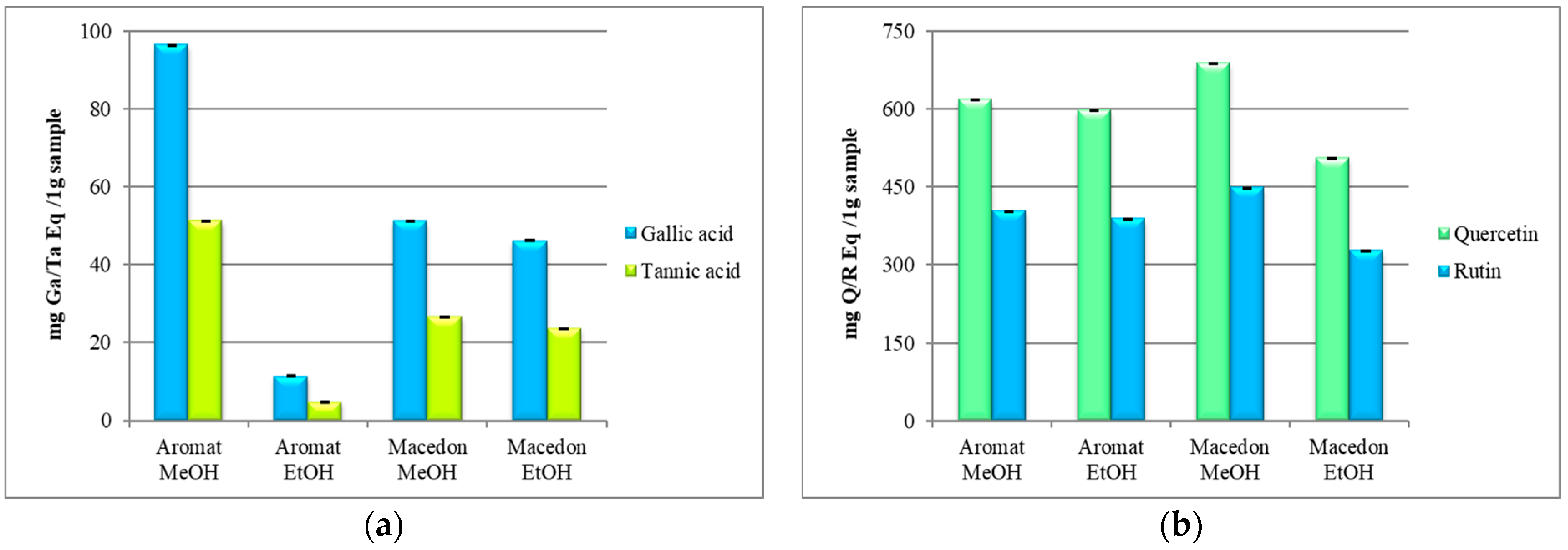
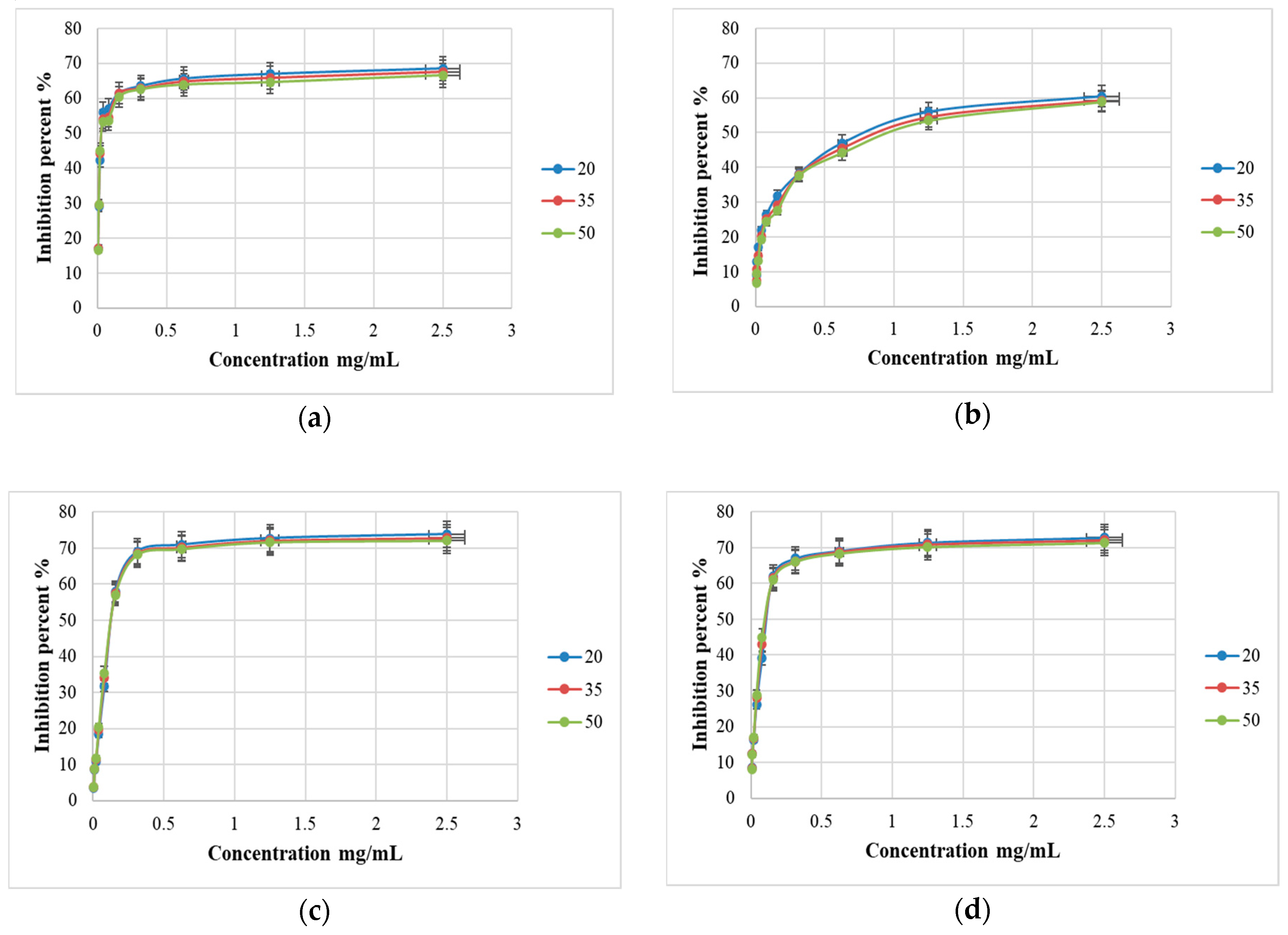


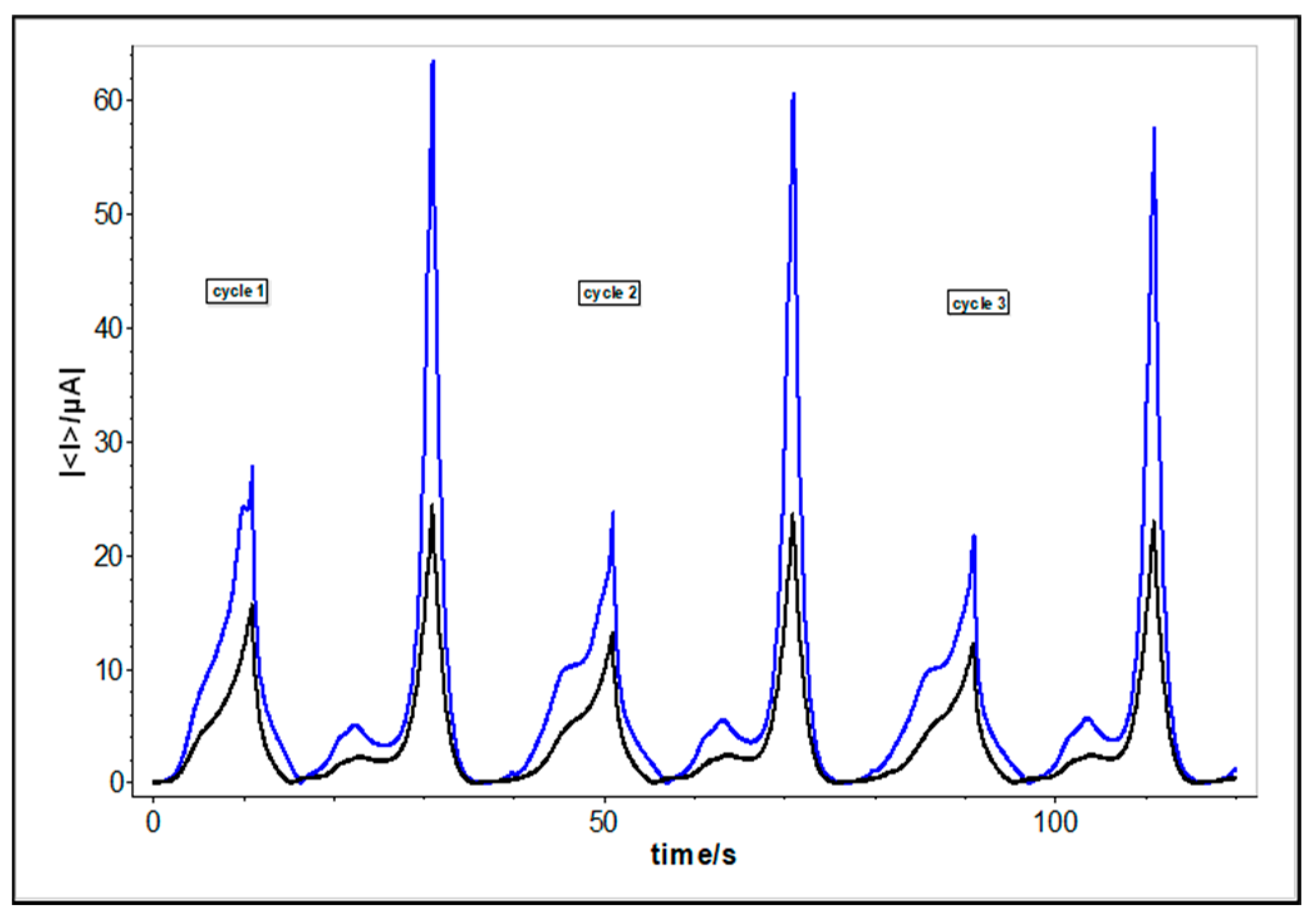
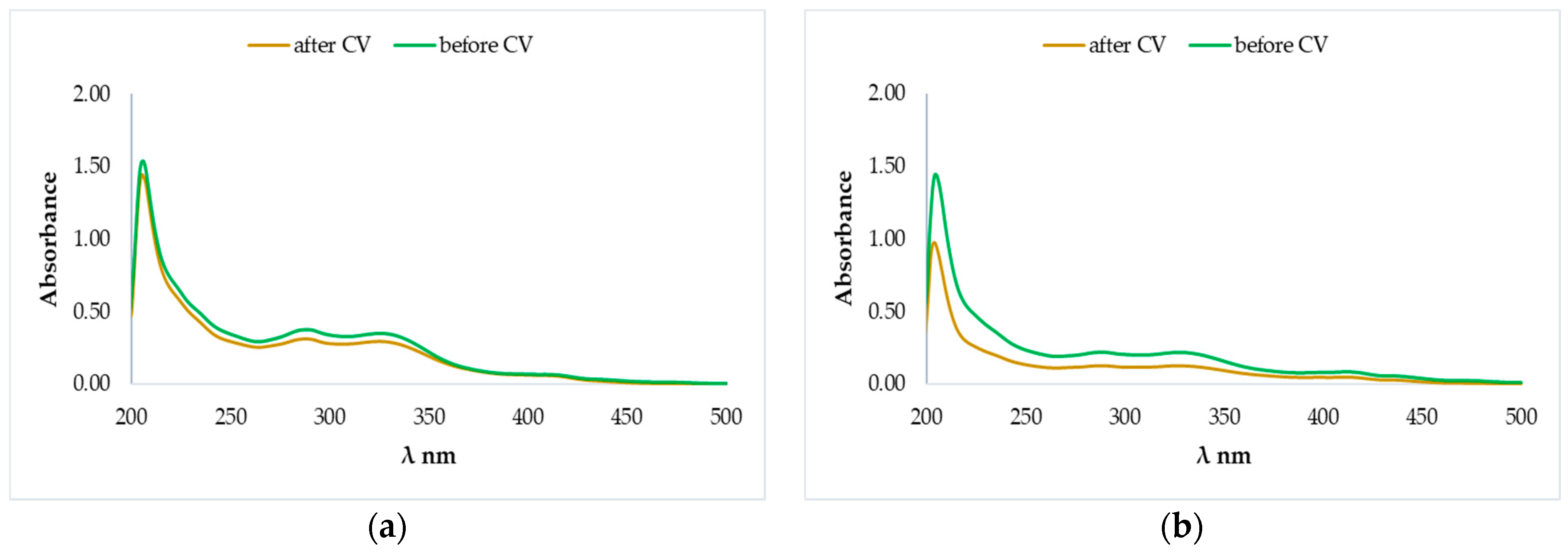
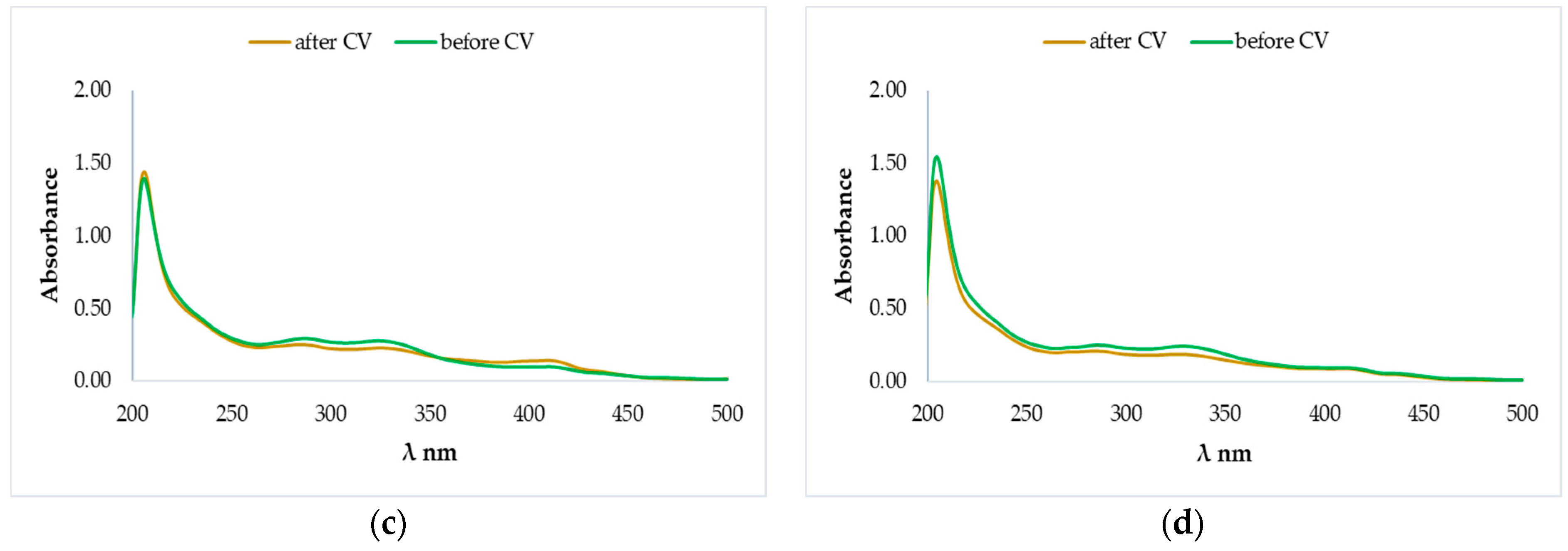
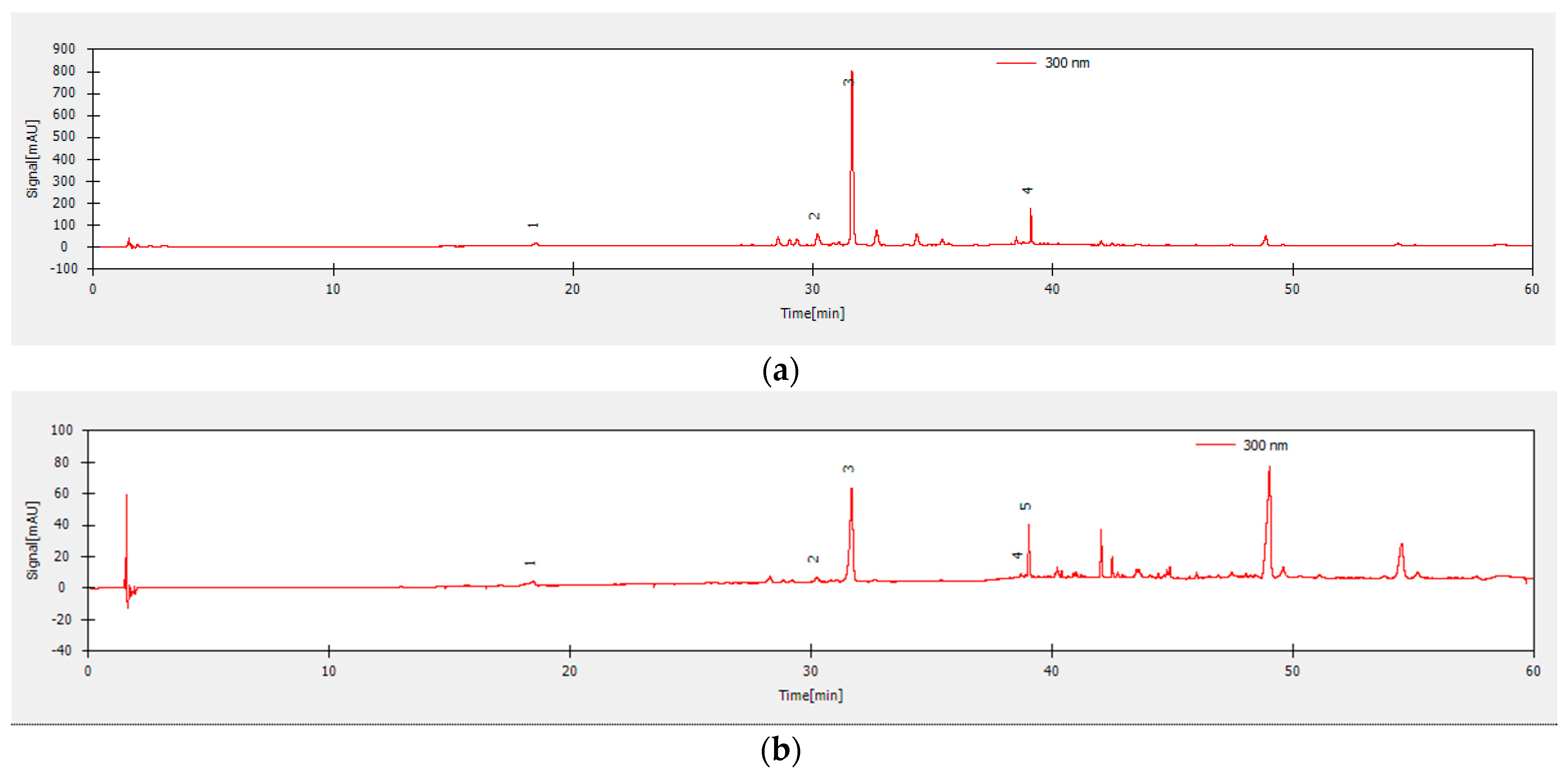
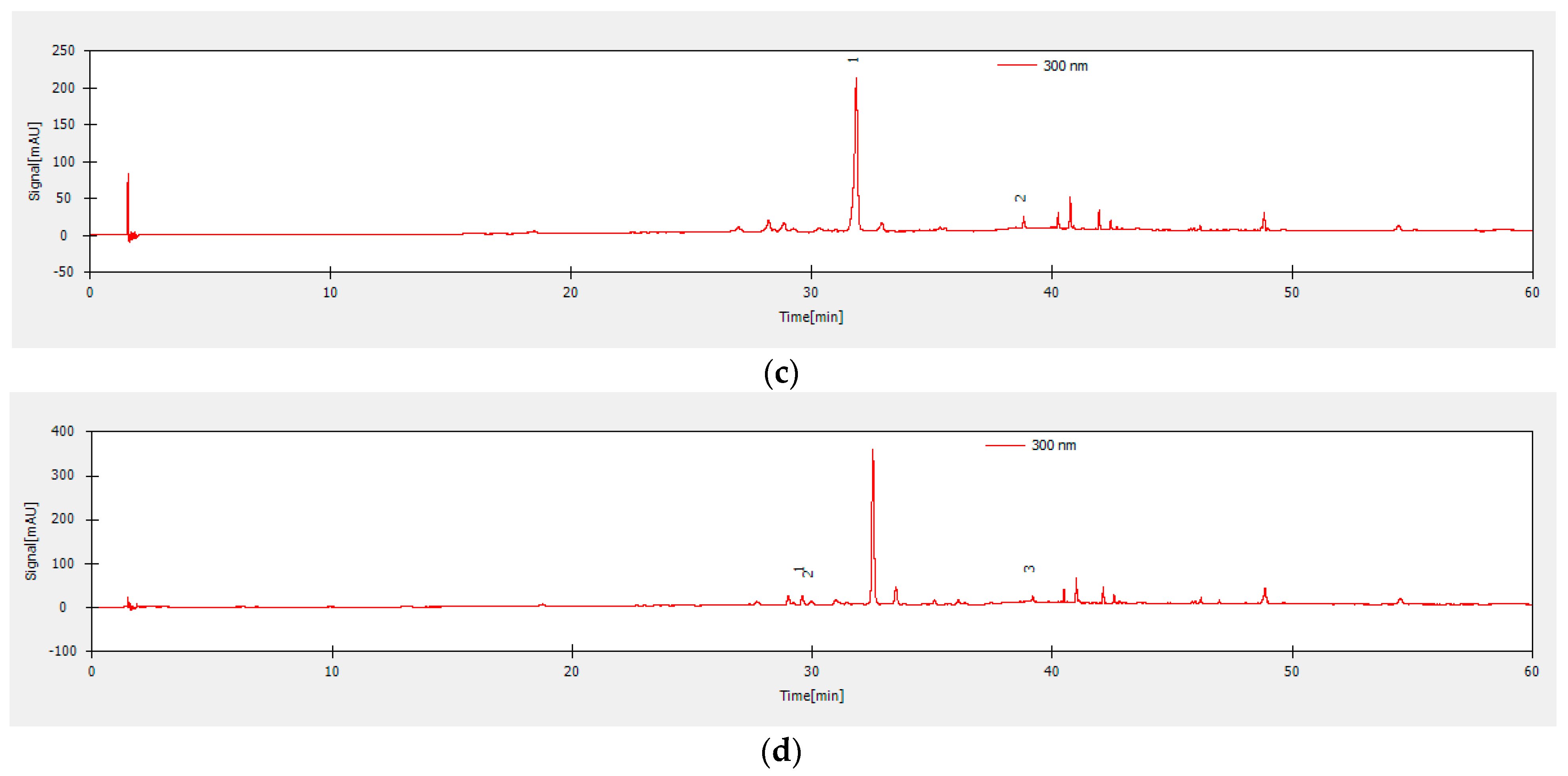


| Compound (mg/kg) | TR * (min) | Aromat MeOH | Aromat EtOH | Macedon MeOH | Macedon EtOH |
|---|---|---|---|---|---|
| Catechin (+) | 19.50 | 0.13 ± 0.01 | 0.23 ± 0.01 | - | - |
| Rutin | 29.78 | 0.78 ± 0.02 | 0.13 ± 0.01 | - | 0.31 ± 0.01 |
| Hyperoside | 29.98 | - | - | - | 0.20 ± 0.01 |
| Naringin | 31.50 | 26.18 ± 0.23 | 2.24 ± 0.09 | 9.30 ± 0.15 | - |
| Naringenin | 38.78 | - | 0.15 ± 0.01 | 0.17 ± 0.01 | - |
| Genistein | 39.10 | 0.50 ± 0.01 | 0.16 ± 0.01 | - | 0.17 ± 0.01 |
© 2020 by the authors. Licensee MDPI, Basel, Switzerland. This article is an open access article distributed under the terms and conditions of the Creative Commons Attribution (CC BY) license (http://creativecommons.org/licenses/by/4.0/).
Share and Cite
Balanescu, F.; Mihaila, M.D.I.; Cârâc, G.; Furdui, B.; Vînătoru, C.; Avramescu, S.M.; Lisa, E.L.; Cudalbeanu, M.; Dinica, R.M. Flavonoid Profiles of Two New Approved Romanian Ocimum Hybrids. Molecules 2020, 25, 4573. https://doi.org/10.3390/molecules25194573
Balanescu F, Mihaila MDI, Cârâc G, Furdui B, Vînătoru C, Avramescu SM, Lisa EL, Cudalbeanu M, Dinica RM. Flavonoid Profiles of Two New Approved Romanian Ocimum Hybrids. Molecules. 2020; 25(19):4573. https://doi.org/10.3390/molecules25194573
Chicago/Turabian StyleBalanescu, Fanica, Maria Daniela Ionica Mihaila, Geta Cârâc, Bianca Furdui, Costel Vînătoru, Sorin Marius Avramescu, Elena Lacramioara Lisa, Mihaela Cudalbeanu, and Rodica Mihaela Dinica. 2020. "Flavonoid Profiles of Two New Approved Romanian Ocimum Hybrids" Molecules 25, no. 19: 4573. https://doi.org/10.3390/molecules25194573
APA StyleBalanescu, F., Mihaila, M. D. I., Cârâc, G., Furdui, B., Vînătoru, C., Avramescu, S. M., Lisa, E. L., Cudalbeanu, M., & Dinica, R. M. (2020). Flavonoid Profiles of Two New Approved Romanian Ocimum Hybrids. Molecules, 25(19), 4573. https://doi.org/10.3390/molecules25194573









